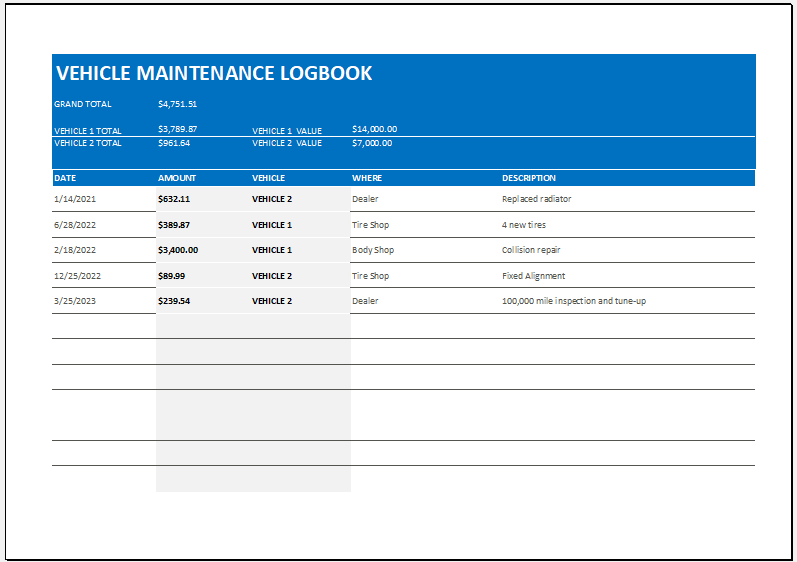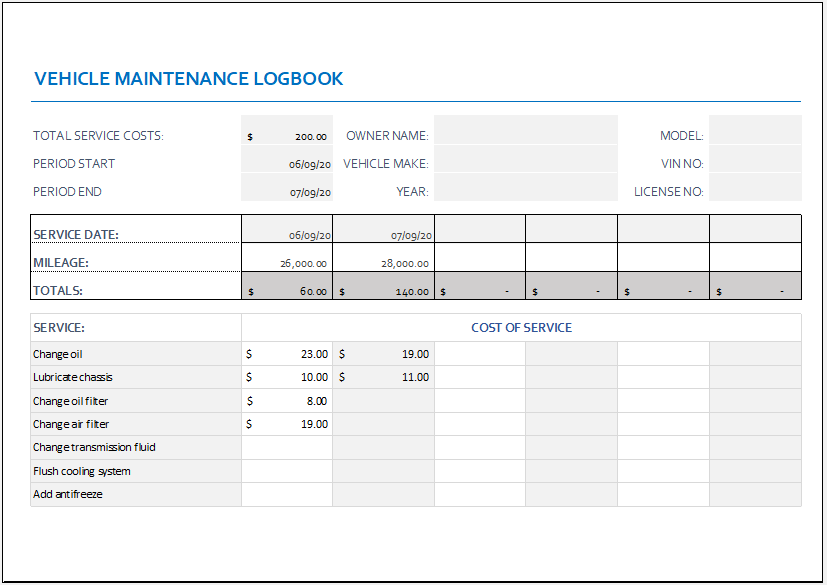A vehicle maintenance logbook is maintained or kept by vehicle, fleet owners, or transport owners and operators for the purpose of keeping a record of the vehicle’s maintenance and repairs. The logbook not only mentions periodic maintenance but also provides information about expenses incurred on maintenance.
Keeping a logbook is a good way to record the vehicle’s condition and keep a track of the vehicle’s inspection matrix. The owner or user of the vehicle can refer to the logbook to perform the required operation if trouble occurs and a vehicle needs to be repaired.
Vehicle maintenance is the practice of maintaining the vehicle, to improve the efficiency and durability of the vehicle’s engine and its components. The maintenance is essential for the longevity of the vehicle, for identifying potential wear, and tear, and for fixing it beforehand. In some cases, such as an accident or sudden failure of any of the vehicle’s parts, maintenance needs to be done on the spot by assessing the damaged part.
Thus, vehicle maintenance can be divided into two main types, as mentioned below:
1- Preventive Maintenance
It is a type of maintenance that is carried out to identify potential trouble before it causes a real problem. The identification and rectification beforehand help in avoiding major risks. It is referred to as the regular inspection of vehicle components at times when they are still functional, to prevent the probability of their failure in times of need.
Though it is cost-effective, because it saves the vehicle’s owner from complex failures which are more expensive, it needs time investment because it needs to be planned, tracked, and regulated. The sub-categories of preventive maintenance are:
- Predictive Maintenance – it is an assessment of the vehicular parts, carried out to estimate the failure point or an estimated time when the potential part would stop functioning. Based on the analysis, the part could be replaced before the malfunctioning occurs, thus saving the cost and risk associated with it.
- Time-Based Maintenance – it is based on regular intervals. The components of the vehicle are inspected at fixed intervals to assess reliability and efficiency. The torn parts can be repaired, and the durability of the remaining parts can be assessed.
- Condition Based Maintenance – it is done by means of equipment of sensors to assess the gather real-time data of vehicular parts data and to bring about necessary action for repairmen or replacement.
- Risk-Based Maintenance – it is carried out for the parts of the vehicle which pose more risk in case of failure. Those parts are regularly monitored and maintained to minimize the damage likely to be caused by the failure.
- Failure Finding Maintenance – it involves a method of inspection that focuses on the malfunctioning of certain vehicular parts, or an assessment to look up for the parts which could have lost their function, but go undetected during normal or regular maintenance.
2- Corrective Maintenance
Unlike preventive maintenance, corrective maintenance is carried out after the failure has occurred or been identified. The purpose to carry it out is, to rectify the issue caused and to restore the function or operation of a vehicle or vehicular part(s).
It is often carried out at the time of condition and time-based maintenance when a failure has been identified and needs to be rectified or a vehicular part needs to be repaired. It is often done at the time of an emergency, accident, or sudden fall out of a vehicle’s part(s).
The above-mentioned are a few strategies that are applied to carry out an assessment of the vehicle and its parts, to identify and rectify a potential problem. Below we will discuss the maintenance types which are essential to keep the vehicle going safely on road.
Minor Maintenance
It is economical, but cannot be neglected. If minor maintenance goes unregulated for the course of the period, it can cause not only damage to a vehicular part but could also result in heavy costs. A few examples of minor maintenance include:
- Changing the engine’s oil, and other lubricants
- Replacement of oil and air filter (s)
- Changing the wiring (if damaged)
- Inspection of tires and lights
- Fixing the vehicle’s minor dent(s)
- Repainting a vehicle
Major Maintenance
It is costly and labor-intensive, usually carried out when a major potential failure is identified or at the time of corrective maintenance. It needs to be immediately dealt, with to restore the function of the vehicle. If unregulated, it could cause serious implications. A few examples of major maintenance include:
- Inspecting gearbox, exhaust systems, and transmission
- Changing the vehicle’s panel
- Inspecting, detecting, and replacing or restoring vehicle’s engine parts
- Inspecting and repairing brake systems
Hence, it is good to regulate the maintenance for the continuity of the vehicle’s operations.
Good practices to ensure good performance
A vehicle owner needs to follow certain below-mentioned practices which can ensure good performance of the vehicle:
- Going for a vehicle’s manufacturer-recommended or authorized service station – local workshops or service stations are cost-effective in the short run, but they undermine the quality of work, which can lead to a major complication in the longer run. When a vehicle or its parts come with a warranty, it should be taken to an authorized service station rather than a local one
- Regulating Vehicle’s Inspection and Service – any of the above-mentioned strategies can be opted for by the vehicle’s owner to regulate the performance
- Preparing Maintenance Checklist – A vehicle’s owner needs to have a checklist to ensure that all tasks under major and minor maintenance are covered
- Preparing and Updating Vehicle Maintenance Logbook – It is essential to have a logbook, which could be used for reference when maintenance needs to be carried out
Maintain and update records regularly
As mentioned, a logbook is good for keep healthy maintenance of a vehicle, provided that it is maintained and updated regularly.
- Maintains Record – A logbook covers all the major and minor maintenance carried out to improve the life and health of a vehicle and could be referred to if any damage occurs within the warranty duration
- Provides information – Using a logbook would not only provide information to a service provider or a vehicle’s owner but to anyone who rides the vehicle and comes across a situation that needs to be dealt with on the spot
- Re-sale – It could be also used at the time of sale and purchase, to provide authentic information about a vehicle’s condition, with all the expenses including service expenses as well
Our website provides templates for the maintenance logbook which are flexible, efficient, and easy to maintain. To provide you with a convenient tool, which can help you monitor, track, regulate, and maintain the health and performance of your vehicle, download, and use freely available templates on our website.
#1

File: Excel (.xlsx) 2007+ and iPad
Size 31 KB
#2

File: Excel (.xlsx) 2007+ and iPad
Size 31 KB
See also:
- Contractor Entry Log Template
- Holiday Party Planner Template
- Marketing Forms Used by Businesses
- HR-related Form Templates
- Personal Finance Tracker
- Daily Dog Care Checklist
- Holiday Shopping Budget Sheet
- Volunteer Work Hour Schedule Worksheet
- Vehicle Booking Sheet Template
- Payroll Audit Report Template
- Bonus Payment Record Sheet
- Overtime Payment Sheet Template
- Meeting Minute Examples
- Vacation Packing Checklist
- Carry-On Essentials List Template